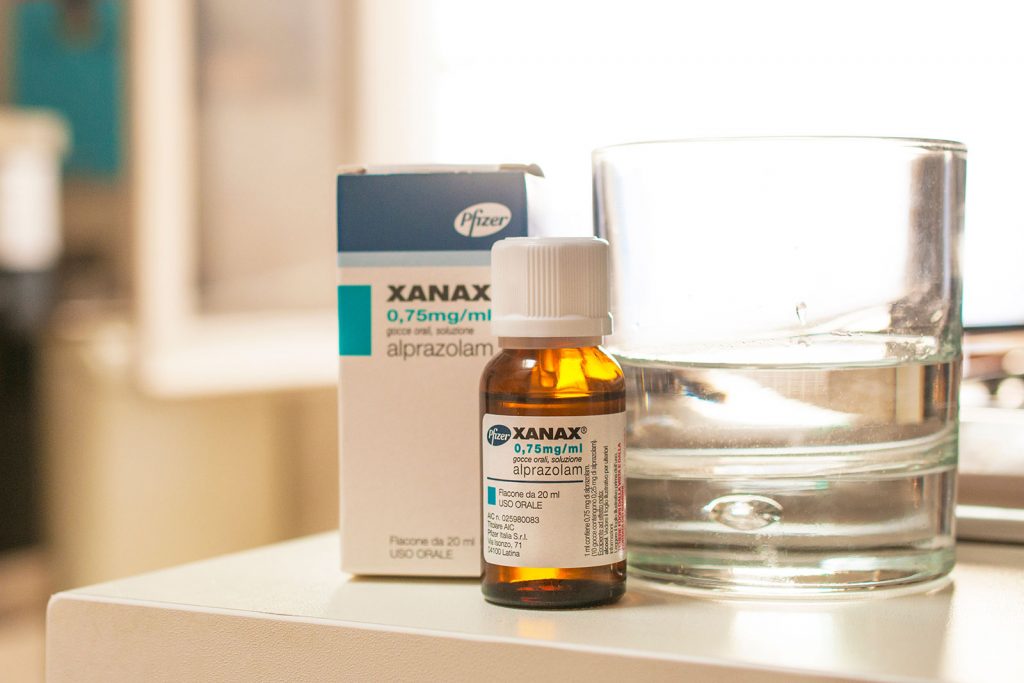Xanax, which is also known by the generic name alprazolam, is an addictive prescription drug that is often used for the treatment of panic attacks and anxiety disorders. It may also be used to treat insomnia, alcohol withdrawal, muscle spasms, seizures, and other conditions. Part of the benzodiazepine drug class, Xanax works on the central nervous system to create a calming effect throughout the body. Specifically, it magnifies the effect of GABA, a natural body chemical, to produce a sensation that can seem pleasing and peaceful.

Table of Contents
ADDICTION AND XANAX ABUSE
Generally, a patient will be prescribed a low dose at first. The dosage may be increased over time until the desired effect is achieved. The medication can cause side effects, so the doctor will attempt to minimize the side effects while optimizing the full benefits of the medication. The specific dosage that a patient is prescribed will depend on a variety of factors, including the diagnosis, the patient’s age, and other factors. Because alprazolam is addictive and because the effects can wear off quickly, doctors may not prescribe this medication for an extended period of time.
However, some patients will seek an even higher dosage than what was prescribed to enjoy the peaceful sensation that the drug provides. This can lead to drug misuse and abuse, and it is a sign of a benzodiazepine addiction. In other cases, an individual who has not been diagnosed and treated by a medical professional may obtain Xanax illegally. When the medication is not properly prescribed by a doctor, the proper dosage for the condition and the patient is not known. This can lead to misuse and abuse. In some cases, those who abuse this medication may not have a diagnosable condition and may simply crave the sense of serenity that it can create. Over time, these individuals who have not obtained a prescription from their doctors may also notice the effects wearing off. As a result, they may increase their dosage on their own to maintain the desired sensation.
Xanax was approved for use by the FDA in 1981, and it is now one of the most widely used psychiatric medications in the United States. Because it is a strong and addictive substance, it is important to only use it under the supervision of a doctor and to follow the doctor’s orders carefully.
SYMPTOMS AND WARNING SIGNS
When Xanax is prescribed by a medical professional, your doctor may work with you to step up the dosage while moderating the symptoms. Common side effects include a change in your sex drive, increased production of saliva, drowsiness, and dizziness. There are also serious side effects that you should talk to your doctor about immediately after you notice them. These include mood changes, suicide ideation, hallucinations, trouble walking, loss of coordination, difficulty speaking and memory problems. Other serious side effects are seizures, yellowing skin or eyes, trouble breathing, and signs of allergic reaction. Signs of an allergy include the development of a rash, swelling, or itching.
To produce its calming effect, alprazolam slows the movement of anxiety-producing brain chemicals. This is achieved by optimizing the power of the natural brain chemical known as GAMA. This medication should not be used with alcohol or with a variety of over-the-counter and prescription medications. Your doctor will review the current medications that you are taking to help you make adjustments as needed. This medication should also not be used by pregnant or breastfeeding women. Driving and using heavy machinery can be dangerous while you are using Xanax. In addition, you should not increase your dosage without a doctor’s order.
Before starting Xanax, it is important to tell your doctor if you have been diagnosed with kidney issues, glaucoma, respiratory issues, an addiction to or overuse of alcohol or other drugs, depression, and liver diseases. In addition, your doctor should be informed if you are allergic to other drugs in the benzodiazepine class. Some of these are Librium, Tranxene, Ativan, Serax, and Valium.
WITHDRAWAL AND XANAX DETOX
You may be suffering from a Xanax addiction if you feel the need to take more than the prescribed amount or if you attempt to get Xanax without a doctor’s prescription. Another sign of a Xanax addiction is feeling unpleasant Xanax withdrawal symptoms when you stop using. According to the Royal College, roughly four out of 10 individuals who take Xanax daily for six weeks will develop an addiction. This is both a physical addiction and a psychological addiction. Because of this duality, a successful treatment program includes medical intervention for detoxification as well as rehab to promote a successful recovery.
The purpose of detoxification from alprazolam is to facilitate the removal of the substance from the body. During this period of time, an addict may experience side effects like blurred vision, mood swings, insomnia, dizziness, and more. Detoxification includes medical oversight to monitor for potentially dangerous withdrawal symptoms. It can also include the use of various types of medications to ease the unpleasant side effects associated with detoxing. These medications commonly include anti-anxiety and anti-convulsion drugs.
TREATMENT AND REHAB
Commonly, Xanax is prescribed for a short-term duration, such as for four weeks or less. The medication’s effects may be felt within 30 minutes or less of taking the drug, but those effects will subside within a few hours. This is one of the reasons why individuals may misuse the drug. With misuse, the likelihood of developing an addiction increases. Treatment plans for an addiction are available through a combination of detoxification and rehab. Detox is complete when the patient’s withdrawal symptoms have subsided. However, mental health conditions such as craving for Xanax may persist. There are several approaches that may be taken to address this aspect of an addiction. One treatment option is cognitive behavioral therapy or CBT. Through this type of therapy, a patient’s eyes may be opened to the thought processes and triggers for abuse. This will then lead to the development of healthier habits and patterns of thought. CBT may also include learning coping skills that can result in a compulsion to use Xanax. Notably, CBT may also be used to treat underlying mental disorders that have contributed to the addiction. This may help the patient to avoid a relapse.
Xanax Bars
When alprazolam is prescribed by a doctor, it may commonly come in an oval shape. There are several different colors of pills, and the color is dependent on the strength of the medication. In some cases, you may find other shapes of Xanax pills. Rectangular bars may be used as well. The bars are the strongest dosage available, which is two milligrams. These are usually sectioned so that the individual can more easily take the right dosage. Often, the bars are what is obtained illegally. In some cases, the Xanax bars obtained on the street may be laced with other drugs, such as pain relievers. Xanax bars are also known commonly as zanies or planks.
Snorting Xanax
Xanax is an oral medication that is not intended to be snorted. However, individuals who misuse the drug commonly will crush it and snort the fine powder. By ingesting Xanax in this way, the effects of Xanax can be experienced much sooner than they would be felt if the pills were ingested orally as intended. In fact, the effect timeline can drop from around 20 to 30 minutes through oral ingestion to two minutes when snorted. The side effects associated with snorting Xanax are similar to those experienced through oral ingestion. Importantly, those who misuse the drug by snorting it may quickly become accustomed to the immediate high that it creates. This can lead to taking the medication more frequently than intended and potentially at higher dosages than recommended or prescribed.
EXPLORE XANAX ADDICTION TREATMENT OPTIONS TODAY
At Recreate Life Counseling, a healthcare provider and addiction treatment center for drug abuse or substance abuse, we provide our patients with a complete treatment program for alprazolam addiction and Xanax use. Through rehab programs, you may get clean safely and potentially with fewer uncomfortable or painful side effects during the recovery process. In addition, you may learn effective coping mechanisms for dealing with cravings and triggers that have contributed to the addiction. To learn more about the treatment options available for an addiction to Xanax, contact Recreate Life Counseling rehab center treatment facility today through our helpline. Don’t wait for life-threatening substance use disorder health conditions that might affect you or your loved one due to drug addiction.


